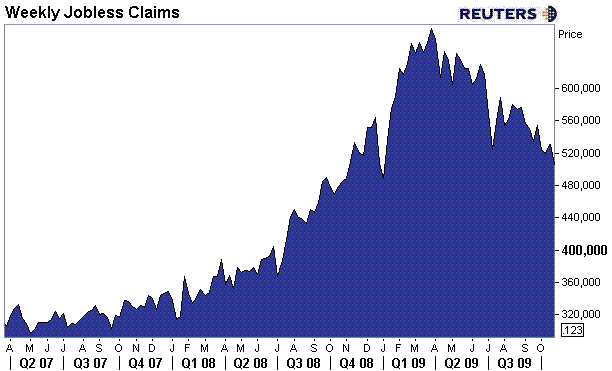The Department of Labor this morning released the Unemployment Insurance Weekly Claims report, also known as Jobless Claims.
This data set tracks new filings for unemployment insurance benefits and the number of Americans who continue to receive state unemployment benefits (called continuing claims or insured unemployment). The fact that this data is released on a weekly basis makes it very appealing to traders and economists as it provides a week over week view into the health of the domestic labor market. Trader's and economists are looking for hints for answers to questions like: Are jobs being created? Are jobs being lost? Does the trend indicate more job losses ahead? Does the trend indicate firms are expanding and hiring more in the process?
Consumers drive output of goods and services in the US. The more workers earn, the more income they have to spend. The more consumers spend the more the economy grows. Because this labor market data has such large implications over the future consumer spending, Jobless Claims are a component of the Leading Economic Indicators.
In the week ending October 31, 2009, jobless claims fell to 512,000 from 532,000 in the previous week, which was revised higher from 530,000. Economists only expected 523,000 new claims for unemployment benefits, so this read was better than expected. This is the lowest number of jobless claims since the week ending January 3, 2009.
The four week average of jobless claims fell to 523,750 from 526,750 in the previous week, which was revised higher from 526,250. The four week average is at its lowest level since the week ending January 10 when it was 523,750.
Continuing Claims fell to 5.749 million from 5.817 million in the previous week, which was revised higher from 5.797 million.
Here is a comparison of recent findings:

Here is a longer term look at trends in Jobless Claims data...

From the Department of Labor...
There were 21,660 former Federal civilian employees claiming UI benefits for the week ending Oct. 17, an increase of 443 from the previous week. Newly discharged veterans claiming benefits totaled 33,900, an increase of 819 from the prior week.
States reported 3,459,148 persons claiming EUC (Emergency Unemployment Compensation) benefits for the week ending Oct. 17, an increase of 90,239 from the prior week. There were 836,629 claimants in the comparable week in 2008. EUC weekly claims include both first and second tier activity.
The highest insured unemployment rates in the week ending Oct. 17 were in Puerto Rico (6.4 percent), Nevada (5.4), Oregon (5.4), California (4.9), Pennsylvania (4.9), Arkansas (4.8), Wisconsin (4.8), Michigan (4.7), Alaska (4.6), North Carolina (4.6), and South Carolina (4.6).
The largest increases in initial claims for the week ending Oct. 24 were in California (+14,394), North Carolina (+3,190), Oregon (+3,131), Georgia (+2,549), and New York (+2,287), while the largest decreases were in Indiana (-2,346), Puerto Rico (-1,479), Iowa (-969), Nevada (-605), and Florida
(-544).
STATES WITH A DECREASE OF MORE THAN 1,000
--------------------------------------------------------------------------------
IN: -2,346. No comment.
PR: -1,479. No comment
--------------------------------------------------------------------------------
STATES WITH AN INCREASE OF MORE THAN 1,000
--------------------------------------------------------------------------------
MD: +1,005.No comment.
TN: +1,048. Layoffs in the service and manufacturing industries.
MI: +1,161.No comment.
WA: +1,190.Layoffs in the construction industry, and agriculture.
NJ: +1,340.Layoffs in the construction, trade, service, transportation, and warehousing industries.
PA: +2,051.Layoffs in the service and manufacturing industries.
SC: +2,084.Layoffs in the manufacturing industry.
NY: +2,287.Layoffs in the construction, service, and manufacturing industries.
GA: +2,549.Layoffs in the construction, trade, and manufacturing industries.
OR: +3,131.No comment.
NC:+3,190.Layoffs in the construction, service, industrial machinery, and transportation industries.
CA: +14,394.Layoffs in the construction, trade, service, and manufacturing industries, and agriculture.
Same story...layoffs in construction, manufacturing, agriculture, and trade industries
It is in our view that the amount of cost cutting performed by many firms combined with seasonal consumer demand influences will result in periods of temporary employment and thus volatility in labor market data. Unfortunately, as hiring rates remain near record low levels, it is expected that the rate of government insured unemployed Americans will remain high.







